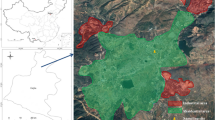Abstract
The indoor air quality issue and its potential health problems are attracting increasingly attentions. In this study, micro-orifice uniform deposit impactor (MOUDI) was used to sample suspended particles from four typical indoor environments, including residence, office, cyber classroom, and chemical analysis room. Size-dependent concentrations of perfluoroalkyl substances (PFASs) and heavy metals in suspended particles were analyzed. Then, the International Commission on Radiological Protection deposition model was employed to estimate deposition efficiencies and fluxes of size-fractioned PFASs and heavy metals in the human respiratory tract. Most of the contaminants deposited in head airways, where coarse particles (aerodynamic diameter or Dp > 1.8 μm) contributed the most. By contrast, in the alveolar region fine particles (Dp < 1.8 μm) were dominant. The chronic daily intake through inhalation of PFASs and heavy metals via airborne particles were 10.3-37.5 pg kg−1days−1 and 3.1-25.9 mg kg−1days−1, respectively. The estimated total hazardous quotient of PFASs and heavy metals were 4.4 × 10−5-1.7 × 10−3 and 9.9 × 10−3-1.05 × 10−1, which is far lower than the acceptable threshold of 1. However, the incremental lifetime cancer risk induced by As, Cd, Co, Cr, and Ni were estimated to be 1.11 × 10−5-1.41 × 10−4 in total, which exceeded the acceptable threshold of 10−6. These findings implicate that there were health risks, especially cancer risks caused by heavy metals associated with airborne particles in urban indoor environments.







Similar content being viewed by others
References
Baptista LF, Miguel ED (2005) Geochemistry and risk assessment of street dust in Luanda, Angola- A tropical urban environment. Atmos Environ 39:4501-4512
Betha R, Behera SN, Balasubramanian R (2014) Southeast Asian smoke haze: fractionation of particulate-bound elements and associated health risk. Environ Sci Technol 48:4327-4335
Birmili W, Allen AG, Bary F, Harrison RM (2006) Trace metal concentrations and water solubility in size-fractionated atmospheic particles and influence of road traffic. Environ Sci Technol 40:1144-1153
Chattopadhyay G, Lin KC, Feitz AJ (2003) Household dust metal levels in the Sydney metropolitan area. Environ Res 93:301-307
Chen YY, Ebenstein A, Greenstone M, Li HB (2013) Evidence on the impact of sustained exposure to air pollution on life expectancy from China's Huai River policy. Proc Natl Acad Sci U S A 110:12936-12941
Eriksson U, Karrman A (2015) World-wide indoor exposure to polyfluoroalkyl phosphate esters (PAPs) and other PFASs in household dust. Environ Sci Technol 49:14503-14511
Fromme H, Tittlemier SA, Volkel W, Wilhelm M, Twardella D (2009) Perfluorinated compounds—exposure assessment for the general population in Western countries. Int J Hyg Environ Health 212:239-270
Giesy JP, Kannan K (2002) Perfluorochemical surfactants in the environment. Environ Sci Technol 36:146A-152A
Goosey E, Harrad S (2012) Perfluoroalkyl substances in UK indoor and outdoor air: Spatial and seasonal variation, and implications for human exposure. Environ Int 45:86-90
Harrad S, Wijesekera R, Hunter S, Halliwell C, Baker R (2004) Preliminary Assessment of U.K. human dietary and inhalation exposure to polybrominated diphenyl ethers. Environ Sci Technol 38:2345-2350
Huang CL, Bao LJ, Luo P, Wang ZY, Li SM, Zeng EY (2016) Potential health risk for residents around a typical e-waste recycling zone via inhalation of size-fractionated particle-bound heavy metals. J Hazard Mater 317:449-456
Jahnke A, Ahrens L, Ebinghaus R, Temme C (2007) Urban versus remote air concentrations of fluorotelomer alcohols and other polyfluorinated alkyl substances in Germany. Environ Sci Technol 41:745-752
Kameda Y, Shirai J, Komai T, Nakanishi J, Masunaga S (2005) Atmospheric polycyclic aromatic hydrocarbons: size distribution, estimation of their risk and their depositions to the human respiratory tract. Sci Total Environ 340:71-80
Kawanaka Y, Tsuchiya Y, Yun SJ, Sakamoto K (2009) Size distributions of polycyclic aromatic hydrocarbons in the atmosphere and estimation of the contribution of ultrafine particles to their lung deposition. Environ Sci Technol 43:6851-6856
Khan S, Cao Q, Zheng YM, Huang YZ, Zhu YG (2008) Health risks of heavy metals in contaminated soils and food crops irrigated with wastewater in Beijing, China. Environ Pollut 152:686-692
Kim KW, Thornton L (1993) Influence of uraniferous black shales on cadmium, molybdenum and selenium in solis and crop plants in the Deog-Pyoung area of Korea. Environ Geochem Health 15:119-133
Li HB, Cui XY, Li K, Li J, Juhasz AL, Ma LQ (2014) Assessment of in vitro lead bioaccessibility in house dust and its relationship to in vivo lead relative bioavailability. Environ Sci Technol 48:8548-8555
Li P-h, Yu J, Bi C-l, Yue J-j, Li Q-q, Wang L, Liu J, Xiao Z, Guo L, Huang B-j (2019) Health risk assessment for highway toll station workers exposed to PM2.5-bound heavy metals. Atmos Pollut Res 10:1024-1030
Lisiewicz M, Heimburger R, Golimowski J (2000) Granulometry and the content of toxic and potentially toxic elements in vacuum-cleaner collected, indoor dusts of the city of Warsaw. Sci Total Environ 263:69-78
Liu B, Zhang H, Yao D, Li J, Xie L, Wang X, Wang Y, Liu G, Yang B (2015) Perfluorinated compounds (PFCs) in the atmosphere of Shenzhen, China: Spatial distribution, sources and health risk assessment. Chemosphere 138:511-518
Liu R, He R, Cui X, Ma LQ (2018) Impact of particle size on distribution, bioaccessibility, and cytotoxicity of polycyclic aromatic hydrocarbons in indoor dust. J Hazard Mater 357:341-347
Lough GC, Schauer JJ, Park JS, Shafer MM, Deminter JT, Weinstein JP (2005) Emissions of metals associated with motor vehicle roadways. Environ Sci Technol 39:826-836
Luo P, Bao LJ, Wu FC, Li SM, Zeng EY (2014a) Health risk characterization for resident inhalation exposure to particle-bound halogenated flame retardants in a typical e-waste recycling zone. Environ Sci Technol 48:8815-8822
Luo P, Ni HG, Bao LJ, Li SM, Zeng EY (2014b) Size distribution of airborne particle-bound polybrominated diphenyl ethers and its implications for dry and wet deposition. Environ Sci Technol 48:13793-13799
Meyer I, Heinrich J, Lippold U (1999) Factors affecting lead, cadmium, and arsenic levels in house dust in a smelter town in eastern Germany. Environ Res 81:32-44
Nesci K (2009) increased scrutiny of flea and tick products for pets. J Environ Health 72:40-41
Nouwen J, Cornelis C, De Fre R, Wevers M, Viaene P, Mensink C, Patyn J, Verschaeve L, Hooghe R, Maes A, Collier M, Schoeters G, Van Cleuvenbergen R, Geuzens P (2001) Health risk assessment of dioxin emissions from municipal waste incinerators the Neerlandquarter (Wilrijk, Belgium). Chemosphere 43:909-923
Pakkanen TA, Kerminen VM, Loukkola K, Hillamo RE, Aarnio P, Koskentalo T, Maenhaut W (2003) Size distributions of mass and chemicalcomponents in street-level and rooftop PM1 particles in Helsinki. Atmos Environ 37:1673-1690
Piekarz AM, Primbs T, Field JA, Barofsky DF, Simonich S (2007) Semivolatile Fluorinated Organic compounds in Asian and Western U.S air masses. Environ Sci Technol 41:8248-8255
Schwanz TG, Llorca M, Farre M, Barcelo D (2016) Perfluoroalkyl substances assessment in drinking waters from Brazil, France and Spain. Sci Total Environ 539:143-152
Shoeib M, Harner T, Ikonomou M, Kannan K (2004) Indoor and outdoor air concentrations and phase partitioning of perfluoroalkyl sulfonamides and polybrominated diphenyls erhers. Environ Sci Technol 38:1313-1320
Shoeib M, Harner T, Wilford BH, Jones KC, Zhu JP (2005) Perfluorinated sulfonamides in indoor and outdoor air and indoor dust occurence, partitioning, and human exposure. Environ Sci Technol 39:6599-6606
Song F, Gao Y (2011) Size distributions of trace elements associated with ambient particular matter in the affinity of a major highway in the New Jersey-New York metropolitan area. Atmos Environ 45:6714-6723
Turner A, Simmonds L (2006) Elemental concentrations and metal bioaccessibility in UK household dust. Sci Total Environ 371:74-81
Wang F, Zhou Y, Meng D, Han M, Jia C (2018) Heavy metal characteristics and health risk assessment of PM2.5 in three residential homes during winter in Nanjing, China. Build Environ 143:339-348
Yao Y, Zhao Y, Sun H, Chang S, Zhu L, Alder AC, Kannan K (2018) Per- and Polyfluoroalkyl Substances (PFASs) in indoor air and dust from homes and various microenvironments in China: Implications for human exposure. Environ Sci Technol 52:3156-316
Young CJ, Furdui VI, Franklin J, Koerner RM, Muir DC, Mabury SA (2007) Perfluorinated acids in arctic snow new evidence for atmospheric formation. Environ Sci Technol 41:3455-3461
Yu LP, Mai BX, Meng XZ, Bi XH, Sheng GY, Fu JM, Peng P (2006) Particle-bound polychlorinated dibenzo-p-dioxins and dibenzofurans in the atmosphere of Guangzhou, China. Atmos Environ 40:96-108
Zhang T, Sun HW, Wu Q, Zhang XZ, Yun SH, Kannan K (2010a) Perfluorochemicals in Meat, Eggs and indoor dust in China assessment of sources and pathways of human exposure to perfluorochemicals. Environ Sci Technol 44:3572-3579
Zhang T, Wu Q, Sun HW, Zhang XZ, Yun SH, Kannan K (2010b) Perfluorinated Compounds in Whole Blood samples from infants, chuldren, and adults in China. Environ Sci Technol 44:4341-4347
Zhang Y, Guo Y, Li G, Zhou J, Jin X, Wang W, Pan X (2012) The spatial characteristics of ambient particulate matter and daily mortality in the urban area of Beijing, China. Sci Total Environ 435-436:14-20
Zhuang P, McBride MB, Xia H, Li N, Li Z (2009) Health risk from heavy metals via consumption of food crops in the vicinity of Dabaoshan mine, South China. Sci Total Environ 407:1551-1561
Funding
This research was financially supported by Guangdong (China) Innovative and Enter-preneurial Research Team Program (no. 2016ZT06N258) and the National Natural Science Foundation of China (project no. 41503087). It was also partially supported by the Fundamental Research Funds for the Central Universities (No. 21617454).
Author information
Authors and Affiliations
Corresponding author
Additional information
Responsible editor: Constantini Samara
Publisher's note
Springer Nature remains neutral with regard to jurisdictional claims in published maps and institutional affiliations.
Rights and permissions
About this article
Cite this article
Lu, X., Cheng, Y., Xiang, M. et al. Size-fractionated particle-bound heavy metals and perfluoroalkyl substances in dust from different indoor air. Environ Sci Pollut Res 26, 36720–36731 (2019). https://doi.org/10.1007/s11356-019-06559-z
Received:
Accepted:
Published:
Issue Date:
DOI: https://doi.org/10.1007/s11356-019-06559-z




